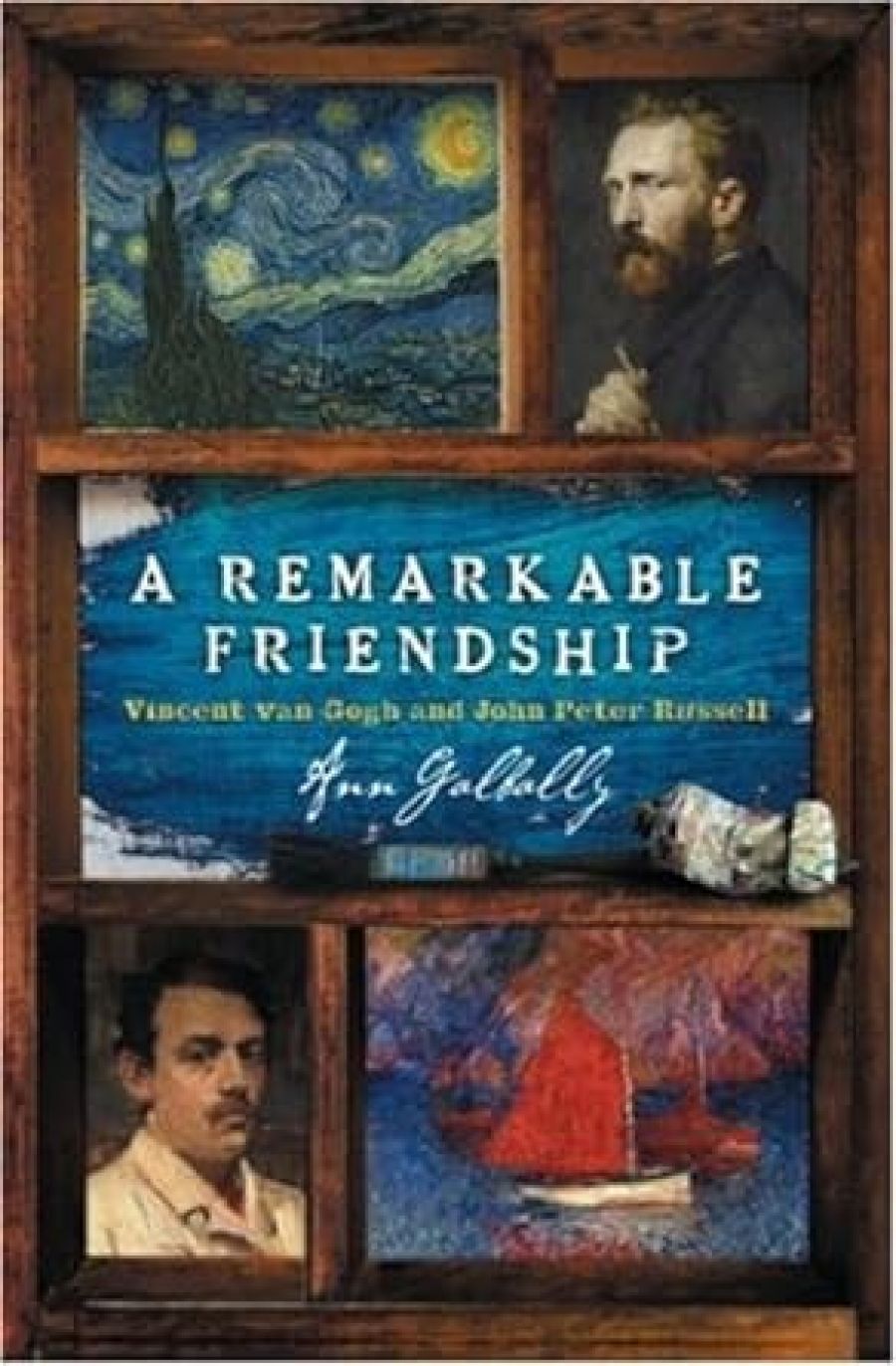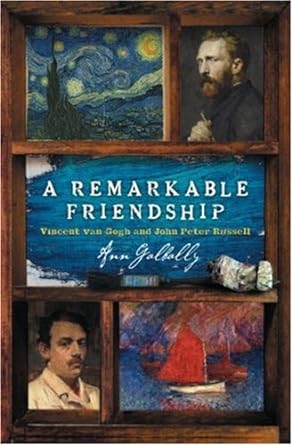
- Free Article: No
- Custom Article Title: Absinthe and amity
- Review Article: Yes
- Article Title: Absinthe and amity
- Online Only: No
- Custom Highlight Text:
In 1880, John Peter Russell left Sydney to seek an artistic education and, like many painters of the time, ended up in Paris. Vincent van Gogh also migrated to the city’s ateliers, and in 1886 they met. The friendship that developed between the twenty-eight-year-old Australian and the thirty-three-year-old Dutchman continued until the latter’s death four years later. Russell painted a penetrating portrait of Van Gogh that captures both the intensity and untrusting nature of his mentally vulnerable subject. The two men exchanged letters, and Van Gogh sent Russell sketches and photographs.
- Book 1 Title: A Remarkable Friendship
- Book 1 Subtitle: Vincent Van Gogh and John Peter Russell
- Book 1 Biblio: Miegunyah, $49.95 hb, 327 pp
- Book 1 Cover Small (400 x 600):

- Book 1 Cover (800 x 1200):

The remarkable nature of their friendship lies partly in the fact that Van Gogh subsequently became extremely famous, whereas Russell remains a footnote in the history of late nineteenth-century and early twentieth-century Australian art. At the time, their camaraderie was perfectly understandable. Both artists were older than most of their fellow students at the atelier of French artist Fernand Cormon; as art historian Ann Galbally points out, their values were more idealistic than the mocking, light-hearted men in their early twenties with whom they shared a studio, men who had little truck with a post-Romantic notion of art as redemptive. They both admired the hopelessly old-fashioned French social realist painter Jean-François Millet, and were undecided about the arguments over colour, whether they agreed with the scientific approach of the pointillist Georges Seurat and the father and son artists Camille and Lucien Pissarro, or the more organic and emotional response to colour as evinced by artists such as Claude Monet and Paul Gauguin. Outside their study hours, they shared a more sober attitude to the temptations of the French capital, neither of them caring much for the garishly seductive nightlife of Montmartre (this would later change, when Van Gogh frequented its bars with Henri Toulouse-Lautrec).
Russell was fascinated with the Dutch artist’s physical appearance, his sunken cheeks and hollow eyes, the suffering and privation of the downward-turning mouth beneath an orange beard. He covered a sheet of paper with studies of Van Gogh’s shaven head, in profile and frowning three-quarter pose. If their rapport was understandable given their age and artistic tastes at the time, it was an attraction of opposites in other ways. Their temperaments and backgrounds could not have been more dissimilar. Van Gogh came from a large, close family, with a father who was a rural pastor in the Dutch Reformed Church, and an environment that was liberal-minded and embraced art; three of Van Gogh’s five uncles were art dealers, as was his brother Theo. As a young man, Vincent himself had joined the London and then the Paris branch of Goupil Galleries, a commercial art dealership which had bought out the businesses of two of the Van Gogh uncles, but which continued to employ various members of the extended family. Mental problems began to surface in Van Gogh’s early twenties. By the time he reached Cormon’s atelier in Paris, he had suffered severe bouts of anguish and physical ill health, had tried, and failed, to become a pastor like his father, had failed in his training for life as a missionary and had abandoned the prostitute with whom he had been living in the Hague. He only dedicated himself to painting in the last ten years of his life. Despite being supported by Theo, it was a life of deprivation.
Russell’s family were quarrelsome, adventurous and wealthy, not particularly supportive, and rarely intimate. Having grown up in Sydney, at the age of twenty-one Russell came into a substantial inheritance, bounty from the family engineering firm of P.N. Russell and Co., which had been wound up two years previously. He found himself in the enviable position of being free to follow any life he chose, his overbearing father having died, and his mother and younger siblings being able to take care of themselves. Suddenly released from expectations that he too would become an engineer (he had already served an apprenticeship in England), he could embrace his first passion, which was art. Since no serious training was to be found in Sydney, he enrolled at the Slade School in London. After four terms under French artist Alphonse Legros, he headed, in 1884, for the centre of the artistic world. Handsome and healthy as Van Gogh was gaunt and broken down, Russell also possessed a sunny optimism, and a love of sporting exertion and opportunities for hearty male bonding. Alongside painting, he had a zeal for rowing, boxing and sailing, and an equal ardour for his striking and self-possessed mistress, an Italian artists’ model called Marianna Mattiocco. By1886 they had a small son, and the happy, unconventional household led an adventurous existence which later translated into a loving stable life together on the Brittany island of Belle Ile.
Although the twin biographies that make up this volume thoroughly fillet the relatively short friendship between the two men, its strengths lie in unpacking the longer and more intense lives that were separately lived. The Van Gogh industry continues to chug out new ingots on the tortured genius’s life, but Galbally gives fresh and unflinching insights in a way that make psychological sense. The same skill and knowledge that made her biography of Charles Conder (Charles Conder: The Last Bohemian, 2002) such an impressive work and a delight to read are at play here too: the detailed examination of painting techniques and theory, the description of the social milieux in which the artists swam, and the economic realities of life for the majority of artists who did not have a trust fund. It is also a fascinating study in contrasting temperaments. Russell’s reluctance to exhibit, and the largely indifferent response when he did, meant that he was not recognised more widely as a bold and lyrical colourist in the post-impressionist style. Instead, with no need to earn a living from his art, after a couple of years in Paris he chose the pleasant existence of an amateur gentleman artist and family man, with lots of good work and an enduring artistic passion, but without a burning zeal to be noticed. He was king of his island domain and had a gift for friendship. These friends include familiar names, such as his early travel companion Tom Roberts, the sculptor Auguste Rodin (who modelled a bust in bronze of Marianna), Monet, who changed his views on colour and landscape, and his influence upon the young Henri Matisse, to whom he taught the principles of colour theory.
It is ironic that, while Van Gogh’s fantasy of creating an artistic commune was only partially realised, and then to the detriment of his mental health (Galbally is especially good on the nuances in the love–hate relationship between the Dutch artist and Gauguin), Russell’s island home attracted many artists, and an informal colony evolved with Russell at its centre. One gets the sense that there is more to Russell’s story than is revealed here, especially in the later years: Galbally hints at a short temper and an autocratic manner, and at bad relations with his five sons and daughter. There is an asymmetry, not just in fame but in the subjects’ personal archives; whereas Van Gogh wrote intense letters to his brother Theo and others, Russell just preferred to go sailing.
The world of the nineteenth-century French artist is a scenario familiar to most: the poverty-stricken garret, the absinthe, the vivid feuds and Bohemian bonhomie. Apart, they each lived one portion of the stereotype: together, Van Gogh and Russell’s lives embodied all these facets. Galbally has written a fascinating study.


Comments powered by CComment